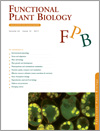
Functional Plant Biology
Volume 44 Number 12 2017
FP17133Expressing Arabidopsis thaliana V-ATPase subunit C in barley (Hordeum vulgare) improves plant performance under saline condition by enabling better osmotic adjustment
Salinity is a global problem affecting agriculture. Here we show that overexpression of vacuolar ATPase subunit C is beneficial in improving barley performance under saline conditions. This effect is explained by transgenic lines being able to rely more on the use of Na+ and K+ for osmotic adjustment rather than spending energy for de novo synthesis of organic osmolytes.
FP16436Roles played by invertase and gene expression in the development of the horn-shaped gall on leaves of Rhus chinensis
Horn-shaped gall is of great value in food, medicine and the industrial field, so the control of its formation will be helpful to increase the products. Vacuolar invertase is related to the rapid expansion of the galls, but ionically bound cell wall invertase is involved in the rapid growth of tissues. This might also be found in other kinds of galls.
FP17033Effects of Ni2+ and Cu2+ on K+ and H+ currents in lily pollen protoplasts
Heavy metals disrupt pollen germination in many species, but the mechanism of their action remained unstudied. Here we report that Cu2+ and Ni2+ affect H+ current and K+ current, respectively, in lily pollen protoplasts; Cu2+ as well enhances reactive oxygen species accumulation. Thus, we reveal the targets for heavy metals (Cu2+ and Ni2+) in the pollen grain plasma membrane.
FP17032Light inhibition of foliar respiration in response to soil water availability and seasonal changes in temperature in Mediterranean holm oak (Quercus ilex) forest
Leaf respiration is an integral component of plant growth and the global carbon cycle, and it is typically lower during the day than at night. We investigated leaf respiration in Mediterranean holm oak woodland, and found that light inhibition was not strongly related to changes in soil water content or ambient temperature. The findings have implications for predictive models that seek to calculate plant carbon balance.
FP17049Variation in shoot tolerance mechanisms not related to ion toxicity in barley
Salinity reduces the grain yield of cereal crops. In this study, nondestructive and destructive phenotyping was used to evaluate 24 predominately Australian barley lines at 0, 150 and 250 mM NaCl. Lines with higher salinity tolerance were better able to maintain their growth rates shortly after salt treatment and exclude Na+ from their shoots. This study shows that variation in shoot tolerance mechanisms unrelated to ion toxicity exists in barley and suggests that breeding new varieties with increased shoot ion-independent tolerance is possible.
FP17165The effect of elevated atmospheric [CO2] and increased temperatures on an older and modern cotton cultivar
Rising atmospheric [CO2] and temperature under projected climate change scenarios may have significant impacts on the physiology and yield of cotton. We quantified the response of cotton cultivars grown in elevated [CO2] and temperature and found substantial potential to increase breeding selection in future climates. Understanding the implications of integrated environmental impacts on cotton is critical for developing cotton systems that are resilient to stresses induced by climate change.
FP16430Possible involvement of phosphoenolpyruvate carboxylase and NAD-malic enzyme in response to drought stress. A case study: a succulent nature of the C4-NAD-ME type desert plant, Salsola lanata (Chenopodiaceae)
In this work we tested the response of PEPC and NAD-ME in the C4-NAD-ME subtype plant Salsola lanata (Chenopodiaceae) under drought stress. Only severe stress limited PEPC enzyme activity (at pH 8.0) significantly, and this was related with decreased PEPC mRNA. More phosphorylated status of PEPC enzyme in plants is under moderate stress compared with other treatments. The change of NAD-ME activity coincided with a change of leaf water content rather than the amount of α-NAD-ME mRNA and protein.
FP17040Small rainfall pulses affected leaf photosynthesis rather than biomass production of dominant species in semiarid grassland community on Loess Plateau of China
Rainfall pulses in water-limited regions significantly affect ecosystem structure and function. After comparing the effects of size and timing of stimulated rainfall pulses on dominant grassland species, we concluded that small pulses had a greater effect on leaf photosynthesis rather than biomass production, and the magnitude was correlated with species type and growth season. These results facilitate the regional eco-adaptability evaluation of species and prediction of vegetation succession under altered rainfall regimes.



